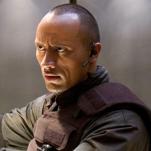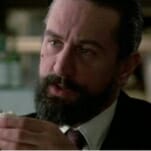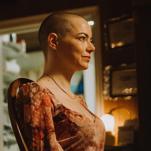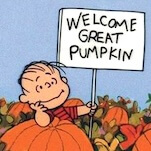The Greats: Lauren Bacall
Whenever an older, revered icon of the film industry dies, there are plenty of testimonials and remembrances written about that person. But it’s sad that we only take the time to fully appreciate these people’s brilliance after their passing. Hence, The Greats, a biweekly column that celebrates cinema’s living legends.
Even after all this time, there’s something strange about seeing Lauren Bacall in color. Maybe it’s because some of her greatest work was in film noir, but she’s always seemed better suited to black-and-white—to a bygone, romanticized vision of the silver screen that probably never actually existed. It’s not just me: Bacall herself longed for a career that was part of Hollywood’s early years. “If I could have lived as an actress in any period,” she once said, “it would have been the 1920s—I would have loved to have been part of that speakeasy era.”
But she came of age at a different time. And then life intervened.
Bacall was born in New York City in September 1924. Her name was Betty Joan Perske, and her father, whom she refers to as a “bastard,” ran out when she was five. “Bacall” came from her grandmother, who was “Bacal.” (“Lauren” would come later when she moved to Hollywood.) Initially, she wanted to be a dancer, but she tried acting and modeling. (“I didn’t think I was ever any good,” she told The Guardian about her modeling days. “I didn’t look at all like any of the other fabulous-looking creatures.”) Her luck changed, though, when she appeared on the cover of Harper’s Bazaar in the spring of 1943. Filmmaker Howard Hawks’s wife Nancy saw the 18-year-old on the front of the magazine and mentioned to her husband that he ought to think about casting her in something.
A year later, her first film hit theaters. To Have and Have Not, the story goes, came together when Hawks made a bet with author Ernest Hemingway that he could make a movie out of Hemingway’s worst novel, which Hawks deemed to be To Have and Have Not. Whether you agree with Hawks’ assessment of the source material, the film (which differs sharply from it) is a classic, and Bacall was on her way, now dubbed Lauren due to Hawks’ prompting.
“[I]t was Howard Hawks who changed my life,” Bacall told Vanity Fair in 2011. “Despite all of his great accomplishments—Bringing Up Baby, Scarface, some of the best pictures to that date—his one ambition was to find a girl and invent her, to create her as his perfect woman. He was my Svengali, and I was to become, under his tutelage, this big star, and he would own me.”
But as much as Hawks wanted to control her—and, apparently, sleep with her—he lost Bacall to her costar. When Bacall had gone to see Casablanca with her aunt a few years earlier, she hadn’t been overly impressed with Humphrey Bogart. “[Aunt] Rosalie was mad about Humphrey Bogart,” Bacall wrote in her 1978 memoir By Myself. “I thought he was good in it, but mad about him? Not at all. She thought he was sexy. I thought she was crazy.” That all changed when she filmed To Have and Have Not with Bogart. Although he was married, Bogart kissed her one night while visiting her trailer. Soon, they were an item—and soon after that, a love story onscreen mirrored one off it. As film critic Leonard Maltin described To Have and Have Not, “It’s one of these instances where it’s quite possible that we are eyewitnesses to an actor or actress falling in love, and while good actors make us believe that all the time, there has to be some extra kick when it’s real.”
Fame and love were hers now, as well as the establishment of her famous persona. Smoky voice—she finally gave up cigarettes in the 1980s—but also tough, funny and vulnerable all at once, Bacall was sexy because, even at a young age, she exuded an adult sophistication. That’s all encapsulated in the movie’s most famous line, her character Slim telling Bogart’s Steve, “You know how to whistle, don’t you, Steve? You just put your lips together and”—pause just long enough—“blow.” It’s delivered with utter confidence and nonchalance, which is even more impressive considering how intimidated she was at first about being in front of the camera. It was Hawks’ suggestion that she calm herself by putting her chin down and looking up that gave birth to her trademark sultry stare, which suggested a lifetime of experience and street smarts in someone so young.
-

-

-

-

-

-

-

-

-

-

-

-

-

-

-

-

-

-

-

-

-

-

-

-

-

-

-

-

-

-

-

-

-

-

-

-

-

-

-

-








































